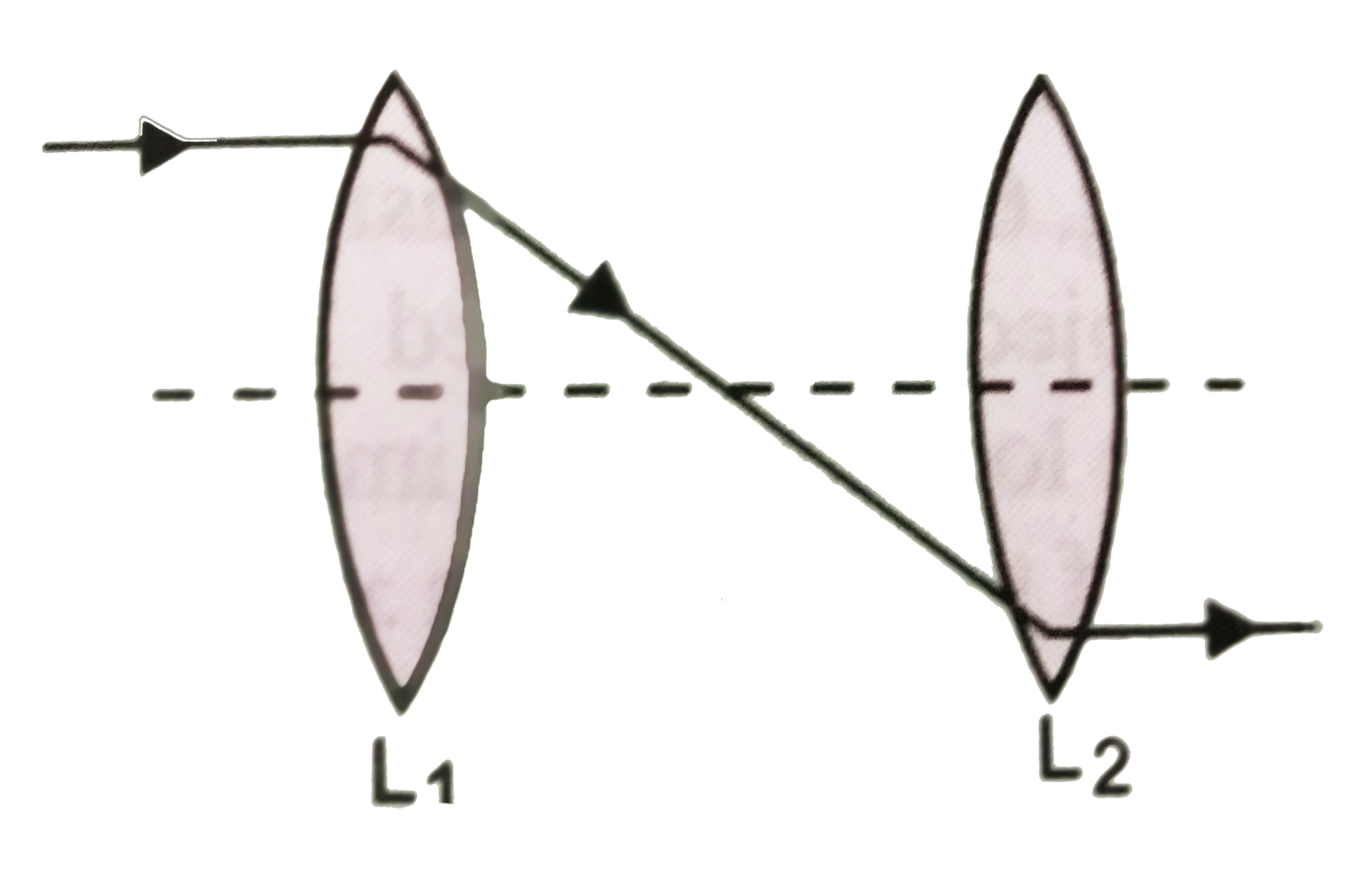You are given three lenses L1,L2andL3 each of focal length 20 cm. An object is kept at 40 cm in front of L1, as shown. The final real image is formed at the focus 'I' of L3. Find the separations between L1,L2andL3.

1v1−1u=1f1 ⇒1v1=1f1+1u1
=120+1−40=1−2−7−40=140
v1=40cm
Here, image by L3 is formed at focus. So, the object should lie at infinity for L3. Hence, L2 will produce image at infinity. So, we can conclude that object for L2 should be at its focus.
But, we have seen above that image by L1 is formed at 40 right of L1 which is at 20 cm left of L2 (focus of L2).
So, X1= distance between L1andL2=(40+20)cm=60cm.
Again distance between L2andL3 does not matter as the image by L2 is formed at infinity. So, X2 can take any value.
Topper's Solved these Questions
- XII BOARDSBook:XII BOARDS PREVIOUS YEARChapter:XII BOARDSExercise:PHYSICS (Theory) [SET - II]
Explore 6 Videos
- XII BOARDSBook:XII BOARDS PREVIOUS YEARChapter:XII BOARDSExercise:PHYSICS (Theory) [SET - III]
Explore 10 Videos
- XII BOARDSBook:XII BOARDS PREVIOUS YEARChapter:XII BOARDSExercise:[Set-III]
Explore 6 Videos
- SAMPLE PAPER 2019Book:XII BOARDS PREVIOUS YEARChapter:SAMPLE PAPER 2019Exercise:SECTION D
Explore 6 Videos
Similar Questions
You are given three lenses L1,L2andL3 each of focal length 10 cm. An object is kept at 15 cm in front of L1, as shown. The final real image is formed at the focus 'T' of L3. Find the separations between L1,L2andL3.

View SolutionThree lenses L1,L2,L3 each of focal length 30cm are placed co-axially as shown in (Fig. 11(b).57).
An object is held at 60cm from the optic centre of lens L1. The final real image is formed at the focus of L3. Calculate separation between
(i) L1 and L3
(ii) L2 and L3 ?
 .
.
View Solution
Knowledge Check
Consider the line L 1 : x 1 y 2 z 1 312 +++ ==, L2 : x2y2z3 123
A0B17√3C413√3D175√3Three lenses L1,L2,L3 are placed co-axially as shown in figure. Focal length's of lenses are given 30 cm , 10 cm and 5 cm respectively. If a parallel beam of light falling on lens L1, emerging L3 as a convergent beam such that it converges at the focus of L3 . Distance between L1 and L2 will be
 A40 cmB30 cmC20 cmD10 cm
A40 cmB30 cmC20 cmD10 cmIn Fig., there are two convex lenses L1 and L2 having focal lengths F1 and F2 respectively. The distance between L1 and L2 will be :
 AF1BF2CF1+F2DF1−F2
AF1BF2CF1+F2DF1−F2
(a) Explain with reason, how the power of a diverging lens changes when (i) it is kept in a medium of refractive index greater than that of the lens, (ii) incident red light is replaced by violet light.
(b) Three lenses L1,L2,L3 each of focal length 30 cm are placed co-axially as shown in the figure. An object is held at 60 cm from the optic center of lens L1. The final real image is formal at the focus of L3. Calculate the separation between (i) (L1andL2)and (ii) (L2andL3).
View SolutionAn eyepiece of a telescope consists of two plano-convex lenses L1 and L2 each of focal length f separated by a distance of 2f/3. where should L1 be plaecd relative to the focus of the objective lens of the telescope so that the final image through L2 is seen at infinity ?
View SolutionL1,L2,L3 are three lines where L1=2x+y=2,L2=x−2y=−1andL3 is any line passing through the point of intersection of L1andL2 A line L passing through P(0,1) intersects L1,L2andL3 at A, B and C respectively. If intercept of L between L1andL2 subtends right angle at origin and (1PA)2+(1PB)2+(1PC)2=5, then find L3 and L.
View SolutionIn the figure shown, there are two convex lenses L1 and L2 having focal. Lengths f1 and f2 respectively. The distance between L1 and L2 will be

View SolutionIn the figure given below there are two convex lenses L1 and L2 having focal lengths F1 and F2 respectively. The distance between L1 and L2 will be

View Solution